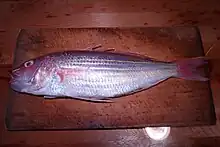| Nemipterus virgatus | |
|---|---|
 | |
| Scientific classification | |
| Domain: | Eukaryota |
| Kingdom: | Animalia |
| Phylum: | Chordata |
| Class: | Actinopterygii |
| Order: | Spariformes |
| Family: | Nemipteridae |
| Genus: | Nemipterus |
| Species: | N. virgatus |
| Binomial name | |
| Nemipterus virgatus (Houttuyn, 1782) | |
| Synonyms[2] | |
| |
Nemipterus virgatus, the golden threadfin bream or yellowlipped threadfin bream, is a species of marine ray-finned fish belonging to the family Nemipteridae, the threadfin breams. This species is found in the Western Pacific Ocean.
Taxonomy
Nemipterus virgatus was first formally described as Sparus virgatus in 1782 by the Dutch naturalist Martinus Houttuyn with its type locality given as Japan.[3] The 5th edition of Fishes of the World classifies Nemipterus within the family Nemipteridae which it places in the order Spariformes.[4]
Etymology
Nemipterus virgatus has the specific name virgatus, which means "striped", an allusion to the yellow longitudinal stripes on the upper body and flanks of this fish.[5]
Description
Nemipterus virgatus has its dorsal fin supported by 10 spines and 9 soft rays while the anal fin contains3 spines and 8 soft rays.[2] Its body has a standard length that is 3.2 to 4 times its depth and it has a snout that is longer than the diameter of the eye. There are 3 or 4 pairs of canine-like teeth in the front of the upper jaw.[6] The pectoral and the pelvic fins are long, extending to between level of anus and origin of the anal fin.[2] The caudal fin is only moderately forked with the upper lobe being extended into a filament. The colour of the upper body is pink becoming paler on the lower body. There is a yellow stripe on the back above the lateral line and 5 more stripes on the flanks below the lateral line. The breast and belly are white. The head is pink with a yellow stripe running from the upper lip onto the lower front margin of the eye, there are sometimes 2 indistinct yellow bars over the cheeks. The eyeis rosy in colour and the upper lip is yellow. The dorsal fin is light pink with a wide yellow margin which has a red edge at the front of the fin, and another yellow stripe immediately above its base. The anal fin is semi-transparent pinkish with a yellow stripe below its margin and a thin yellow stripe immediately over its base, extending to tip of last soft ray. The caudal fin is pink with a yellow upper margin and extended. The pelvic fins are pinkish, with a yellow line along the second and third fin rays and the pectoral fins are semi-transparent and pinkish.[6] The maximum published standard length of this fish is 35 cm (14 in), although 23 cm (9.1 in) is more typical.[2]
Distribution and habitat
Nemipterus virgatus is found in the Western Pacific Ocean where it is found in southern Japan, the East China Sea, and the northern part of the South China Sea where it ranges from Vietnam to the Taiwan Strait, and the Philippines. There is a separate population in northwestern Australia and the Arafura Sea.[1] The golden threadfin bream is a demersal fish which is found at depths between 1 and 220 m (3 ft 3 in and 721 ft 9 in), although juveniles tend to be in shallower water than the adults typically between 18 and 33 m (59 and 108 ft). over sandy and muddy substrates.[2]
Biology
Nemipterus virgatusis a rudimentary hermaphrodite, the males have functional male gonads but also have some ovarian tissue for their whole life. In the South China Sea spawning occurs between February and June, peaking between February and April. They feed on smaller fishes, crustaceans and cephalopods.[6]
Fisheries and conservation
Nemipterus virgatus is an important target species for commercial fisheries in the east China Sea and South China Sea where it is caught using handlines, longloines and bottom trawls, while the juveniles are caught in large numbers as bycatch in shrimp trawl fisheries. The annual catch of this species declined by 30% in the ten years up to 2010 and the IUCN assesses it as Vulnerable.[1]
See also
References
- 1 2 3 Carpenter, K.; Matsuura, K.; Collette, B.; et al. (2010). "Nemipterus virgatus (errata version published in 2017)". IUCN Red List of Threatened Species. 2010: e.T154900A115250542. doi:10.2305/IUCN.UK.2010-4.RLTS.T154900A115250542.en. Retrieved 9 November 2023.
- 1 2 3 4 5 Froese, Rainer; Pauly, Daniel (eds.) (2023). "Nemipterus virgatus" in FishBase. October 2023 version.
- ↑ Eschmeyer, William N.; Fricke, Ron & van der Laan, Richard (eds.). "Species in the genus Nemipterus". Catalog of Fishes. California Academy of Sciences. Retrieved 10 November 2023.
- ↑ Nelson, J.S.; Grande, T.C.; Wilson, M.V.H. (2016). Fishes of the World (5th ed.). Hoboken, NJ: John Wiley & Sons. pp. 502–506. doi:10.1002/9781119174844. ISBN 978-1-118-34233-6. LCCN 2015037522. OCLC 951899884. OL 25909650M.
- ↑ "Order SPARIFORMES: Families LETHRINIDAE, NEMIPTERIDAE and SPARIDAE". The ETYFish Project Fish Name Etymology Database. Christopher Scharpf. 17 October 2022. Retrieved 10 November 2023.
- 1 2 3 B. C. Russell (2001). "Nemipteridae". In Carpenter, K.E. & Neim, Volker H. (eds.). The Living Marine Resources of the Western Central Pacific Volume 5: Bony fishes part 3 (Menidae to Pomacentridae) (PDF). FAO Species Identification Guide for Fishery Purposes. FAO Rome. p. 3063.
